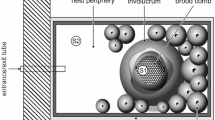Abstract
Honeybees, Apis spp., maintain elevated temperatures inside their nests to accelerate brood development and to facilitate defense against predators. We present an additional defensive function of elevating nest temperature: honeybees generate a brood-comb fever in response to colonial infection by the heat-sensitive pathogen Ascosphaera apis. This response occurs before larvae are killed, suggesting that either honeybee workers detect the infection before symptoms are visible, or that larvae communicate the ingestion of the pathogen. This response is a striking example of convergent evolution between this "superorganism" and other fever-producing animals.
Similar content being viewed by others
Author information
Authors and Affiliations
Additional information
Received: 2 September 1999 / Accepted in revised form: 28 February 2000
Rights and permissions
About this article
Cite this article
Starks, P., Blackie, C. & Seeley, T. Fever in honeybee colonies. Naturwissenschaften 87, 229–231 (2000). https://doi.org/10.1007/s001140050709
Issue Date:
DOI: https://doi.org/10.1007/s001140050709




